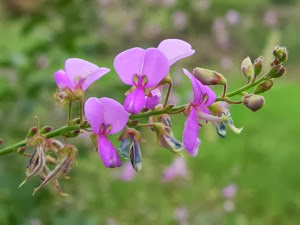The illustrations of our late friend Linda Ellis that fill our basement includes this one which was the design for a tee-shirt for MONPS. It summarizes the collections we make while hiking through the Ozarks. It also raises the recurring question we get as Master Naturalists, "What good are ___________? " You can fill in the blank but it can range from mosquitoes to to annoying seeds. I will focus on beggar's lice, also called tick trefoil. Those names highlight the negative so I will use their lyrical genus name, Desmodia.
Pause for a moment to read aloud to yourself this poem by Mary Elizabeth Mahnkey, poet laureate of the Ozark Hills. I have extracted it from the Ozarkswatch Magazine published by Missouri State University, a great resource for all things Ozarkian.
 |
| Desmodium flower 1/4" Missouriplants.com |
 |
| Missouriwildflowerguide.com |
These Deesmodia blossoms attract a wide variety of long-tongued bees. With the blossom long gone, September is the time that they start to spread the seeds. I know that all plants have their place, I just wish
that my pant leg wasn't one of them. Desmodium is also called tick trefoil, beggar's lice, stick
tights, hitch hikers, and occasionally"@*%^$#". There are 19 species
in Missouri which can only be identified by getting close enough for
their seeds to grab your clothes.
 | |
| Seed pods - Missouri Extension |

 |
| Desmodium 40, Smokey 0 - REK |
When I scrape a cluster of seed pods off my legs, I try to tell myself that they are a great native plant. They are eaten by quail, turkey and white-footed mice. The plant serves as a food source for deer, rabbits, groundhogs and birds Lots of insects such as weevils, beetles, leaf eating larvae and aphids eat them, many of which are then eaten by quail. When dry in late season, you can open the seedpod, exposing the tiny seed that has a pleasant nutty flavor.
 |
| Eastern Tailed Blues - Jon Rapp |
 |
| Eastern Tailed Blue |
Best yet, Desmodia sp. are the host plants for caterpillars of the Eastern Tailed Blue, Everes comyntas, and the Gray Hairstreak, Strymon melinus. This is beauty you can behold for most of the summer without getting on your hands and knees. One more reason to get in touch with nature and forgive plants and animals with annoying features. All native species have a place. We just have to understand that place to answer the question "What good are _______?"
You can see the In Touch With Nature shirt design full size here.
Thanks, Linda.

